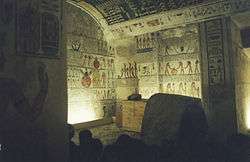KV9
Tomb KV9 in Egypt's Valley of the Kings was originally constructed by Pharaoh Ramesses V. He was interred here, but his uncle, Ramesses VI, later reused the tomb as his own. The layout is typical of the 20th dynasty – the Ramesside period – and is much simpler than that of Ramesses III's tomb (KV11). The workmen accidentally broke into KV12 as they dug one of the corridors. In 2020, the Egyptian Tourism Authority released a full 3D model of the tomb with detailed photographies, available online.[1]
| KV9 | |||
|---|---|---|---|
| Burial site of Ramesses V & Ramesses VI | |||
 | |||
 KV9 | |||
| Coordinates | 25°44′24.6″N 32°36′04.7″E | ||
| Location | East Valley of the Kings | ||
| Discovered | Open in antiquity | ||
| Excavated by | James Burton Georges Daressy | ||
Decoration

The entrance is decorated with a disk containing a scarab and an image of the ram-headed Ra between Isis and Nephthys who are kneeling. The jambs and thicknesses, mentions the name of Ramesses VI. The jambs are usurped from Ramesses V.[2]
First corridor
On both sides are images of Ramesses VI before Ra-Harakhti and Osiris. The scenes originally depicted Ramesses V but were usurped. On the south wall of the corridor are scenes from the Book of Gates, while the North wall is decorated with scenes from the Book of Caverns.[2]
Hall
_fifth_division.jpg)
The corridor ends in a hall that is decorated with an intricate astronomical ceiling.[3] On the left (south) wall the Book of Gates is continued. The decorations show divisions 10 and 11 including Nun holding up the bark of Ra with Nut above the scene. On the right side of the hall (the north) the Book of Caverns scenes continue. Above the entrance to the next corridor the king is shown censing and libating before Osiris. Ramesses VI is shown in a variety of scenes before gods and goddesses such as Meretseger, Khonsu, Ptah and Ptah-Sokar-Osiris.[2]
Second corridor
In the descent to the second corridor the decorations show scenes from the Book of the Imi-Duat. The ceiling depicts the barks of Ra and the Books of the Day and Night. Ramesses VI is shown before Hekau, and Maat.[2]
Hall and burial chamber
The last hall contains scenes from the Book of the Dead and the Book of Aker.[2]
Later history
In the Graeco-Roman period, the tomb was identified as that of Memnon, the mythological king of the Ethiopians who fought in the Trojan War. As a result, it was frequently visited; 995 graffiti left by visitors have been found on the temple walls, ranging from the 1st century BC to the 4th century AD.[4] They were left by pilgrims, mostly Greeks, who in the Ptolemaic and Roman periods traveled to the site from different parts of Egypt and the Mediterranean.[5] The inscriptions were written in black or, less frequently, red ink, mainly in Greek but also in Latin, Demotic, and Coptic.[6] They appear in different parts of the tomb, usually on the upper parts of the walls, which corresponds to the higher floor level (the corridors were partly filled in at that time).[5] Visitors’ names form the majority of the graffiti, but there are also longer texts which provide more information about their authors, including their occupation. They tell us that philosophers, doctors, and high-ranking officials were among the pilgrims.[5] Some of the texts are of a religious character (proskynema).[6] The graffiti are being studied since 1996 by the Epigraphical Mission from the Polish Centre of Mediterranean Archaeology University of Warsaw in cooperation with the Egyptian Ministry of Antiquities.[7]
References
- "Pharaoh Ramses VI Tomb". Egyptian Tourism Authority. 2020-04-15. Retrieved 2020-04-15.
- Porter, Bertha and Moss, Rosalind, Topographical Bibliography of Ancient Egyptian Hieroglyphic Texts, Statues, Reliefs and Paintings Volume I: The Theban Necropolis, Part 2. Royal Tombs and Smaller Cemeteries, Griffith Institute. 1964, pg 511-517
- Dodson, Aidan and Ikram, Salima, The Tomb in Ancient Egypt, Thames and Hudson, 2008, pg 227-9
- Foertmeyer, Victoria Ann (1989). Tourism in Graeco-Roman Egypt (PhD). Princeton University. p. 27.
- Łukaszewicz, Adam (2013). "Polish Epigraphical Mission in the Tomb of Ramesses VI (Kv 9) in the Valley of the Kings in 2010; Appendix by Małkowski, W., Bogacki, M., Kaniszewski, J.: Three-dimensional spatial information system for the graffiti inside the Tomb of Ramesses VI (KV 9) in the Valley of the Kings" (PDF). Polish Archaeology in the Mediterranean. 22.
- "Dolina Królów, Grobowiec Ramzesa VI (KV 9)". pcma.uw.edu.pl. Retrieved 2020-06-22.
- "Valley of the Kings, Tomb of Ramesses VI (KV 9)". pcma.uw.edu.pl. Retrieved 2020-06-22.
Literature
- Reeves, N & Wilkinson, R.H. The Complete Valley of the Kings, 1996, Thames and Hudson, London.
- Siliotti, A. Guide to the Valley of the Kings and to the Theban Necropolises and Temples, 1996, A.A. Gaddis, Cairo.
- Łukaszewicz, A., with appendix by Małkowski, W., Bogacki, M., Kaniszewski, J. Polish Epigraphical Mission in the Tomb of Ramesses VI (Kv 9) in the Valley of the Kings in 2010; Appendix: Three-dimensional spatial information system for the graffiti inside the Tomb of Ramesses VI (KV 9) in the Valley of the Kings, Polish Archaeology in the Mediterranean, 22 (2013)
External links
| Wikimedia Commons has media related to KV9. |
- Theban Mapping Project: KV9 - Includes description, images and plans of the tomb.
- Virtual exploration of KV9
- Views of KV9 & KV12